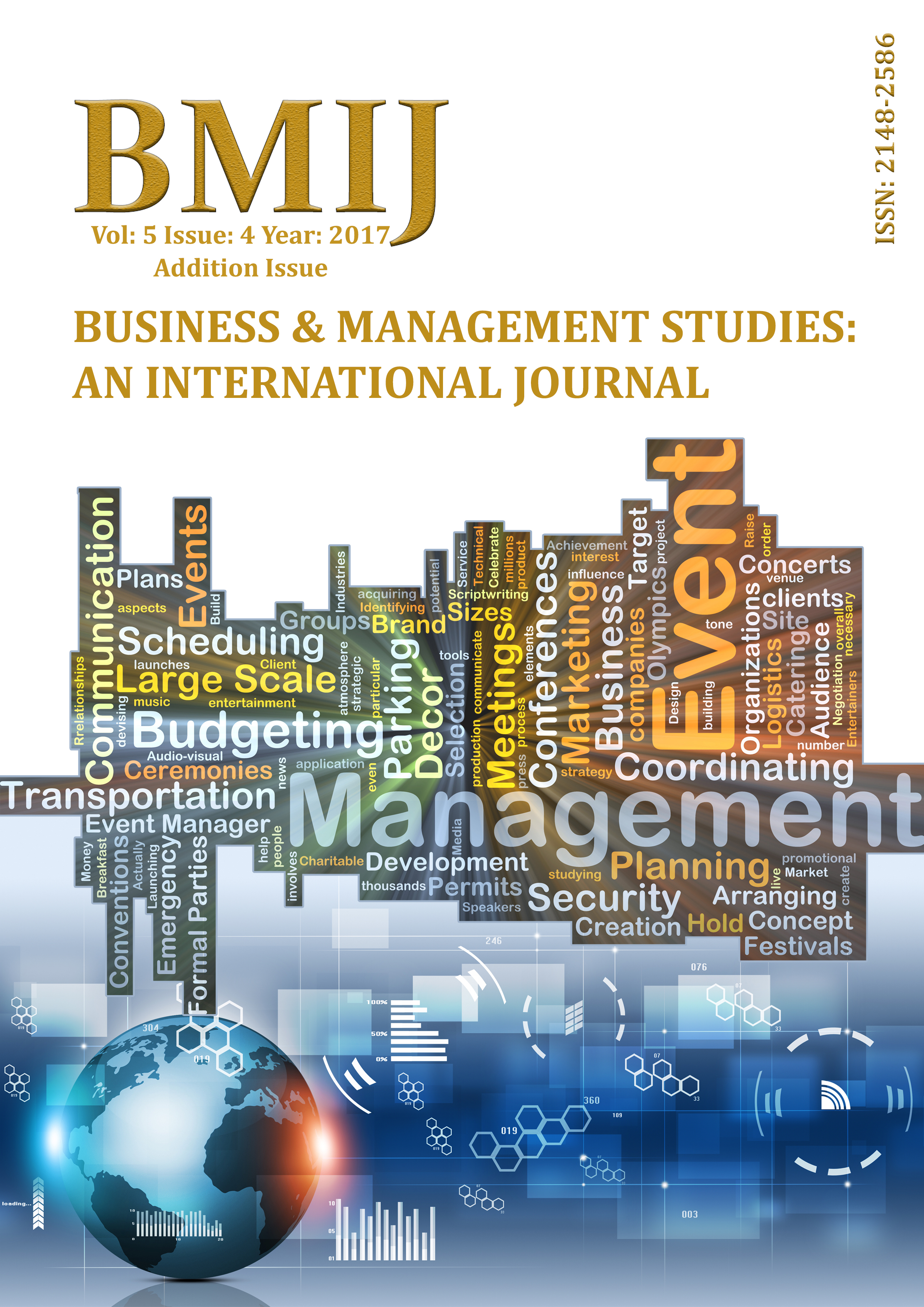Makaleler
İFLAS ETME OLASILIKLARINI BULANIK MANTIK VE MERTON MODEL KULLANARAK TAHMİN ETME: ABD ŞİRKETLERİ ÜZERİNE BİR UYGULAMA

Yayınlanmış 07.01.2018
Anahtar Kelimeler
- MertonModel,
- Faktor Analizi,
- Kümeleme,
- Bulanık Mantık.
Nasıl Atıf Yapılır
İFLAS ETME OLASILIKLARINI BULANIK MANTIK VE MERTON MODEL KULLANARAK TAHMİN ETME: ABD ŞİRKETLERİ ÜZERİNE BİR UYGULAMA. (2018). Business & Management Studies: An International Journal, 5(4), 211-234. https://doi.org/10.15295/bmij.v5i4.168
Nasıl Atıf Yapılır
İFLAS ETME OLASILIKLARINI BULANIK MANTIK VE MERTON MODEL KULLANARAK TAHMİN ETME: ABD ŞİRKETLERİ ÜZERİNE BİR UYGULAMA. (2018). Business & Management Studies: An International Journal, 5(4), 211-234. https://doi.org/10.15295/bmij.v5i4.168
Öz
Bu çalışmada bulanık-iflas endeksi altında yeni bir endeks oluşturduk. Endeksin amacı ait olduğu sektörden bağımsız herhangi bir X şirketinin varsayılan iflas etme olasılığını bulmaktır. Bulanık-iflas mantık endeksi finansal oran kesişim değişikliğini zamandan ve sektörden bağımsız olarak yorumlar. Yeni endeks finansal rasyoların farklı karar verme durumunu ortadan kaldırmak için de oluşturduk. Oluşturulan yeni değişkenin dört tanesi kümeleme ve faktör analizi sonuçlarından elde edilmiş olup, diğer değişken ise Merton modelinden elde edilmiştir. İflas etmiş şirketlerin geçmiş tarihteki olayları analiz edilirken; dolandırıcılık ve yönetim hataları gibi farklı birçok neden ile karşılaşılır. Buna örnek olarak Enron ve K-Mart gibi prestijli firmalar gösterilir. Bu tür durumlardan dolayı bu çalışmada herhangi bir şirketin finansal durumunun dahi iyi anlaşılabileceği bir model tasarlanmayı hedeflemektedir. Bu model kredi yatırım şirketlerinin yanlış şirkete yatırım yapmalarını ve muhtemelen tüm yatırımlarını kaybetmelerini önleyebilir.Referanslar
- Bandemer, H. and Gottwald, S. (1995). Fuzzy Sets, Fuzzy Logic, Fuzzy Methods with Applications, Wiley, New York, NY, USA.
- Benos A. and Papanastasopoulos G. (2005). Extending the Merton Model: A Hybrid Approach to Assessing Credit Quality. http://econwpa.repec.org/eps/fin/papers/0505/0505020.pdf
- Bharath S. T. and Shumway T. (2004). Forecasting Default with the KMV-Merton Model, Working Paper in University of Michigan.
- Black, F., and Scholes, M. (1973). The Pricing of Options and Corporate Liabilities. Journal of Political Economy, 81, 637-659.
- Crouhy. M. Galai. D., Mark. R. (2000). A Comparative Analysis of Current Credit Risk Models. Journal of Banking and Finance.
- D'amico, G. (2008). A Convergence Result in the Estimation of Markov Chains with Application to Compound Options. Journal of Statistical Theory and Practice, 2(4), 693-705.
- Duffie D. and . Leandro A, Saita. Ke Wang. (2006). Multi-period Corporate Default Prediction with Stochastic Covariates, Journal of Financial Economics. 59-117.
- Duffie, D., & Singleton, K. J. (2012). Credit risk: pricing, measurement, and management. Princeton University Press.
- Chen, D. H., Chou, H. C., Wang, D., &Zaabar, R. (2009). the Predictive Performance of a Barrier Option Credit Risk Model in an Emerging Market. Working Paper.
- Groenen, P. J., Kaymak, U., & van Rosmalen, J. (2007). Fuzzy clustering with Minkowski distance functions. Fuzzy Clustering and its Applications, Wiley, 53-68.
- Haack, S. (1979). Do we need “fuzzy logic”?. International journal of man-machine studies, 11(4), 437-445.
- Hull J. C., Options (1997). Futures and Other Derivatives. Prentice Hall.
- Hull J., White A., Joseph L. Rotman. (2000). Valuing Credit Default Swaps I: No Counterparty Default Risk, April.
- Hull, J., Nelken, I., & White, A. (2004). Merton’s model, credit risk, and volatility skews. Journal of Credit Risk Volume, 1(1), 05.
- Miyake, M., & Inoue, H. (2009). A default probability estimation model: An application to Japanese companies. Journal of Uncertain Systems, 3(3), 210-220.
- Merton, R. C. (1974). On the pricing of corporate debt: The risk structure of interest rates. The Journal of finance, 29(2), 449-470.
- Lin, S., Ansell, J., &Andreeva, G. (2007). Merton models or credit scoring: modelling default of a small business. University of Edinburgh Management School
- Saretto, A. (2005). Predicting and pricing the probability of default.
- Shnaider, E., &Kandel, A. (1989). The use of fuzzy set theory for forecasting corporate tax revenues. Fuzzy Sets and Systems, 31(2), 187-204.
- Huschens, S., Vogl, K., &Wania, R. (2005). Estimation of default probabilities and default correlations. In Risk Management (pp. 239-258). Springer Berlin Heidelberg.
- Tudela, M., & Young, G. (2005). A Merton-model approach to assessing the default risk of UK public companies. International Journal of Theoretical and Applied Finance, 8(06), 737-761.
- Zadeh L.A. (1965). Fuzzy sets. Info. &Ctl, Vol. 8. 338-353.
- Zadeh L.A. (1968). Fuzzy Algorithms. Info. &Ctl, Vol. 12. 94-102.
- Zadeh, L. A. (1984). Making computers think like people [fuzzy set theory]. IEEE spectrum, 21(8), 26-32


